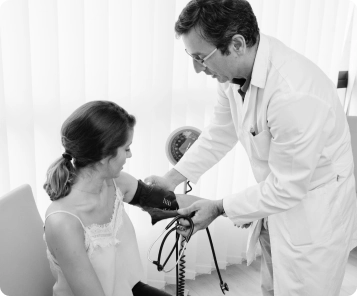Minor Procedures

Types of Minor Procedures We Provide
Minor procedures differ depending on the health concern being addressed. MedWise® providers are well-trained to perform the following minor procedures in our urgent care clinics: Laceration and wound repair, ingrown toenail removal, splinting of fractured bone, abscess incision, and drainage (I&D), and earwax removal.
Cuts, wounds and lacerations Repair
Lacerations occur when the skin is cut or torn. MedWise® providers repair lacerations using sutures, staples, liquid adhesive, or adhesive wound closure strips, depending on the severity and location of the wound.
We may also administer tetanus shots, topical antibiotics, or oral antibiotics as needed.
A laceration with possible damage to tendons, ligaments, neurovascular systems, vision, and facial aesthetics may require evaluation in the emergency department.
Abscess Incision & Drainage
An abscess is a collection of pus caused by an infection and can be present anywhere in the body. Symptoms include a swollen lump, fever, pain, redness, and warmth in the affected area.
MedWise® providers can perform a small incision to drain the abscess and may prescribe antibiotics to treat the underlying infection.
SYMPTOMS
- Swollen lump under skin
- Fever
- Chills
- Pain
- Warmth
- Redness
Ingrown Toenail Removal
An ingrown toenail occurs when the corner or edge of the toenail grows into the surrounding skin. It often affects the big toe but can affect any of your toes.
Symptoms may include pain or tenderness, inflamed skin, swelling, redness, warmth, and drainage. Common causes include trimming toenails too short, injuring a toenail or wearing poorly fitting shoes.
Treatment may include soaking the foot in warm water, manually lifting the affected toenail using floss or cotton, and prescribing over the counter pain relievers and/or antibiotics.
For severe cases, a MedWise® provider may numb the toe and perform partial or complete toenail removal.
Symptoms
- Pain
- Swelling
- Redness
- Drainage
Bone Fracture Splints
A fracture is a medical term for a broken bone. Fractures are often caused from trauma, such as motor vehicle accidents, falls or sports injuries. Symptoms of bone fractures include pain or tenderness, swelling, limitation in movement, bruising or discoloration, and a bump or deformity that isn’t usually present.
MedWise® offers digital X-ray services to determine the existence and location of a broken bone. Common types of bone fractures that we treat include the foot, ankle, hand, arm, elbow, finger, and toe. If a bone is broken, a MedWise® provider will evaluate the type of fracture and recommend appropriate care and treatment, such as splinting of the affected limb.
A splint is a piece of material that is used to immobilize and support a body part. Splints are often used when an individual fractures a part of their body (e.g., wrist, arm, finger, or leg). A splint may be used to immobilize and support a specific body part throughout the healing process.
Common types of fractures we treat
- Foot
- Ankle
- Hand
- Arm
- Elbow
- Finger
- Toe
Types of Bone Fractures
Although it is common to refer to broken bones by their placement (e.g., broken arm or broken leg), there are also different types of fractures. Common types of bone fractures include:
- Stress fracture: Also known as a hairline fracture where the bone looks like it has a crack in it.
- Partial or incomplete fracture: The bone is cracked but not completely broken.
Complete fracture: The bone completely breaks into two or more pieces. - Closed or simple fracture: The bone breaks but does not penetrate through the skin.
- Open or compound fracture: The bone punctures through the skin and is visible.
Because not all bone fractures are the same, treatment varies depending on the type, location, and severity of the injury. In some cases, a splint, along with rest will be sufficient, but other times surgery may be required.
Simple fractures on bones such as a finger, wrist, ankle, or toe can be treated by a MedWise® provider. Individuals with more serious fractures that require specialized or emergent treatment will be referred to an orthopedic specialist or emergency department.
- Pain is triggered by very little movement or light pressure.
Heavy bleeding.
You suspect a bone is broken in the head, neck, or back.
The bone is broken in multiple pieces.
Bone sticking through your skin or there is obvious deformity.
The extremity of the injured arm or leg, such as a finger or toe, is numb or bluish at the tip.
Earwax Removal
Earwax (cerumen) acts as a self-cleaning agent and protects your ears from dirt and infection. However, sometimes earwax can build up and cause problems. Symptoms of cerumen impaction may include decreased hearing, clogged ear sensation, minor discomfort in one or both ears, ringing in the ears, and dizziness.
If MedWise® providers determine that you have an earwax impaction, we can manually remove the excess earwax or perform ear irrigation. This involves gentle pulsations of warm water into the ear canal to break up the impaction.
After the earwax removal, our providers may also discuss at-home treatment options to help prevent future occurrences.
Impaction Symptoms
- Decreased hearing
- Clogged ear sensation
- Minor discomfort in one or both ears
FOREIGN BODY REMOVAL
A foreign body is an object stuck in the body that has been introduced from the outside. When you have been punctured by an object and its remnants remain in your body, it is important that the wound is explored by a provider to try and retrieve the foreign body before infection and complications occur.
While some foreign bodies can be removed easily (e.g., splinter, pencil lead, or glass), others may require surgical intervention. The decision to remove a foreign body is based on symptoms, risk of complications, or if the object is causing pain.
The removal process depends on where the foreign body is located and what it is. Many foreign bodies can be removed by a MedWise® provider, but dangerous objects lodged internally or deep within the skin may require surgical removal.
Minor Procedures FAQs.
How do I know if my laceration needs stitches?
If the cut is deep, longer than half an inch, or has edges that won't close, you may need stitches. Lacerations on the face, hands, or joints should be evaluated by a healthcare provider.
Can an abscess heal on its own?
While small abscesses may resolve with home care, larger or more painful abscesses require professional drainage to prevent infection and complications.
When should I seek treatment for an ingrown toenail?
How long does it take for a bone fracture to heal?
Healing times vary depending on the type and location of the fracture. Simple fractures can heal in 4-6 weeks with rest and immobilization, while more complex fractures may take longer.
Can earwax buildup cause hearing loss?
Yes, excessive earwax buildup can block the ear canal and lead to temporary hearing loss. Professional earwax removal can restore hearing and prevent further complications.

APPLY HERE
This website is provided for educational and informational purposes only and does not constitute providing medical advice or professional services. The information provided should not be used for diagnosing or treating a health problem or disease, and those seeking personal medical advice should consult with a licensed health care provider. Always seek the advice of your doctor or other qualified health provider regarding a medical condition. If you think you may have a medical emergency, call 911 or go to the nearest emergency room immediately. No physician-patient relationship is created by this website or its use. Neither MedWise nor its employees, nor any contributor to this website, makes any representations, express or implied, with respect to the information provided herein or to its use.
